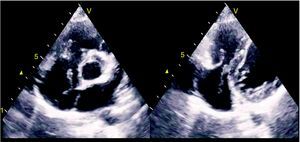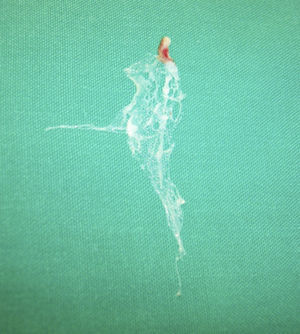To the Editor,
An 11-year-old boy was admitted to the Emergency Room referring sudden episodes of palpitations followed by syncope; he has no past medical history. Blood tests including thyroid function were normal. Electrocardiogram (ECG) showed an atrial fibrillation with ventricular response at 180 bpm. No structural or functional pathology was established, and different antiarrythmic drug strategies were tried, but episodes continued to occur. Echo scan (Figure 1) showed a strongly developed Chiari's network on his right atrium, with no atrial septal defect. Because of its size, we observed a continuous violent flicking against lateral wall of the atrium. No abnormality other than the presence of Chiari's network could explain these episodes despite an exhaustive electrophysiology study, which induced no arrhythmias.
Figure 1. 2D-echocardiogram image showing Chiari's network in right atrium moving towards tricuspid valve.
After various antiarrhytmia treatments had no effect, he underwent surgical excision of Chiari's network (Figure 2) through a simple thoracotomy, with no surgical complications.
Figure 2. Surgical sample of a highly developed Chiari's network removed from right atrium.
To our knowledge, this is the first description of paroxysmal atrial fibrillation triggered by Chiari's network. It has been reported to appear in up to 4% of autopsy studies,1, 2 and is frequently associated with patent foramen ovale but is believed to be of little clinical consequence.3, 4, 5 Nevertheless, recent studies suggest some clinical role in some cases of thrombosis, causing embolic events.6, 7, 8, 9, 10
The surgical excision has been effective to date. No recurrence of arrhythmia or syncope has been detected after 4 years of follow-up and Holter ECG, the boy's development has been completely normal and he regularly engages in intense physical exercise.
Corresponding author: Instituto Cardiológico, Clínica Rotger, Santiago Russiñol 9, 07012 Palma de Mallorca, Baleares, Spain. ealegriabarrero@secardiologia.es




